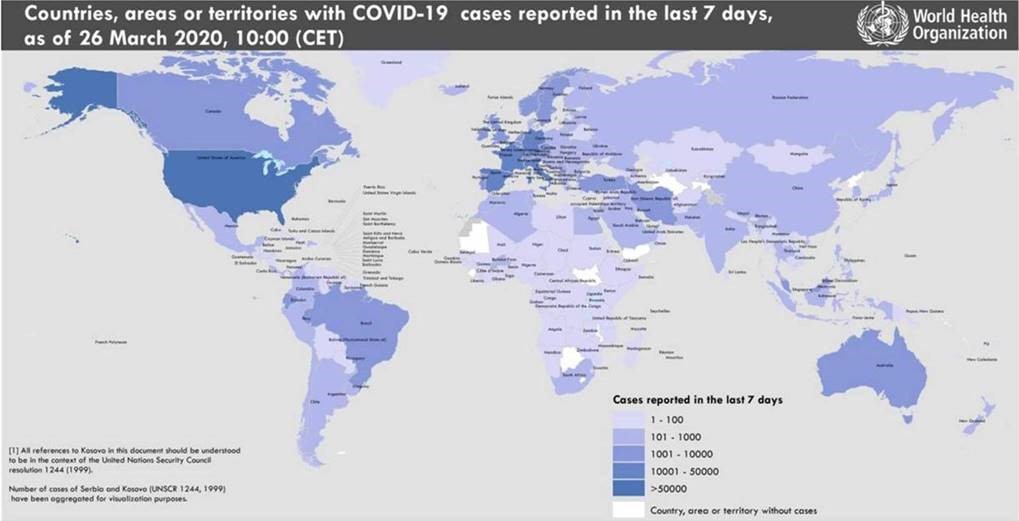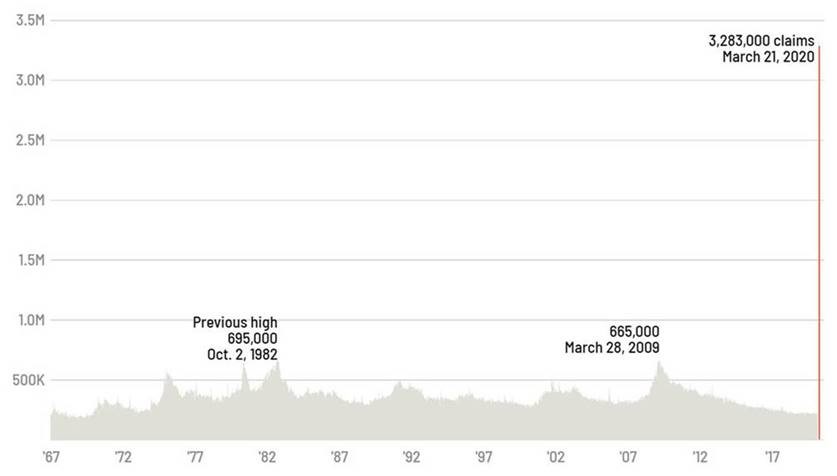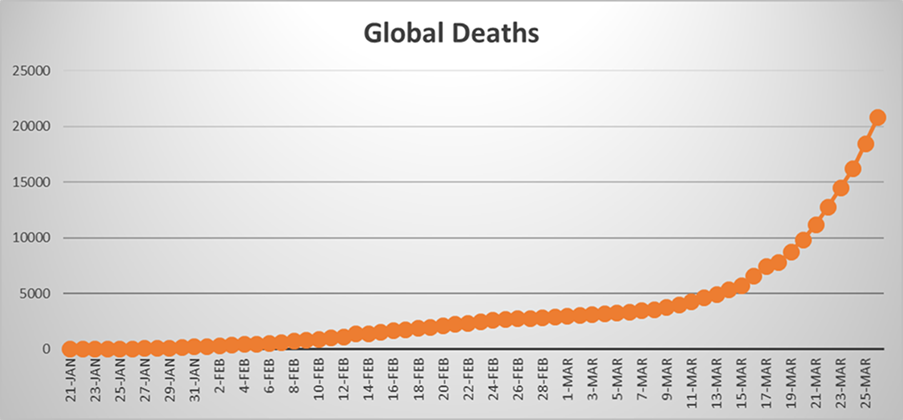Here are Thursday’s COVID-19 headlines and helpful tidbits.
Washington, D.C.
- FEMA has a “How to Help” website for COVID-19 which includes donations, volunteering, and private sector subcategories.
- The EPA is relaxing enforcement of multiple environmental regulations because of worker shortages and travel restrictions caused by COVID-19, per a memo circulated today. This has caused a stir in the environmental activism community as many facilities benefiting from the relaxed standards are still operating under full capacity.
- President Trump sent a letter to America’s governors today saying the federal government hoped to provide a risk assessment for individual counties in conjunction with increased testing capabilities. In the letter, the President says that counties will be classified as high, medium or low risk to help local policymakers make decisions about whether to maintain, increase, or relax social distancing standards.
- NIAID’s Dr. Tony Fauci said today the Phase I vaccine trials have begun and that he hopes larger Phase II or Phase III trials can begin by the middle of summer.
- HHS banned the hoarding or price-gouging of N95 respirator masks, ventilators, gloves, and other personal protective equipment. The hoarding ban includes hydroxychloroquine after reports of the drug selling out at pharmacies. The list of banned materials can be found here.
- The House Committee on Homeland Security compiled this resource guide for DHS’s response to COVID-19.
- Sen. Rand Paul (R-KY) and Reps. Mario Diaz-Balart (R-FL) and Ben McAdams (D-UT) are still the only members of Congress who have tested positive for COVID-19; however, 26 other members are now in self-quarantine. Four members have completed a self-quarantine.
Updates from the States
- Out of the cases under investigation detected by U.S. surveillance, there are total cases: 68,440 travel-related: 636 “close contact”: 1,074 The CDC now updates data Monday through Friday and data closes out the day before reporting.
- The CDC is reporting 994 deaths in the U.S. related to COVID-19. Since these numbers close out the day before reporting, deaths in the U.S. have now exceeded 1,000.
- Despite some optimism yesterday, New York’s hospitalized patient population increased by 40 percent in one day. Of those hospitalized, about one-fifth were in intensive care.
- The Ohio legislature moved the official primary date to April 28th and created a new plan, under which approximately 7.8 million registered voters in Ohio will receive postcards with instructions for applying for a ballot. Ballots postmarked by April 27th will be counted in the primary. Voters who are disabled or who do not have a permanent address will be allowed to vote in person at their local elections boards.
- COVID-19 “hot spots” are popping up in Midwestern cities like Detroit and Chicago.
- Colorado Gov. Jared Polis has issues a statewide stay at home order, and has also signed an executive order to limit evictions, foreclosures, and public utility disconnections to provide relief to Coloradans affected by COVID-19.
- This series of maps shows how states are responding to COVID-19, and this tracker, created and maintained by MultiState Associates, has an up-to-date list of executive orders and various travel restrictions.
Military/Defense
- The Navy has begun testing all 5,000 people aboard the aircraft carrier USS Theodore Roosevelt after eight sailors tested positive for the coronavirus.
- There are 227 cases of COVID-19 among active duty service members, up from 133 on Monday. The rate of service member cases is about 175 per million troops, which surpasses the U.S. at a large rate of 135 per million.
- More than 11,400 Guard troops have been mobilized in an effort to combat COVID-19. Governors across all 50 states, Puerto Rico, Guam, the U.S. Virgin Islands, and Washington D.C. have mobilized components of their Army and Air National Guard to assist in their state’s response to the COVID-19 pandemic. Additionally, eight states have approved the use of Dual-Status Commanders, giving them the authority to command active and reserve component troops under control of a state’s governor.
- DoD’s Office of Industrial Policy has a website offering resources for industry navigating responses to COVID-19.
- The Navy is making opportunities available for current sailors to extend enlistments and for veterans to return to the fleet as measures to boost manning during and after the pandemic. The decision comes on the heels of a DoD-wide order to suspend all travel, deployments, and exercises across the entire military as the Pentagon struggles to mitigate the spread of COVID-19.
- In an effort to deal with COVID-19 impacts, the Air Force will move to four-week repeating cycles for basic training recruits and will test an alternate location to train them. The changes will reschedule the March 31st arrival date for the next batch of trainees, and decrease the number reporting for training by about a third.
- The USNS Comfort is set to leave Norfolk, VA this weekend and arrive in Manhattan by Monday, three weeks earlier than originally anticipated.
International Affairs
- The U.S. now has the highest number of confirmed COVID-19 cases globally (more than both China and Italy).
- China has closed its borders to foreign nationals who live there starting Saturday at midnight. The government announced that it would suspend entry for nearly all foreign nationals holding valid visas and residence permits, including all visa-free transit policies. It does not apply to visas issued to diplomats or flight crew, or to people traveling to China for “necessary economic, trade, scientific or technological activities or out of emergency humanitarian needs.”
- Minors from Central America who arrive alone at the U.S. border are being turned away without the usual legal process under the new locked-down border policy in an effort to curb the spread of COVID-19. The new policy, issued as a public health measure under the legal authority of the surgeon general, bans tourist traffic along the borders with Mexico and Canada, and says that migrants who cross illegally or who present themselves for asylum can be returned to their countries immediately, without access to the legal process they would have gone through in the past.
- Spain had to send about 9,000 faulty test kits back to China after they did not meet required criteria. The test kits originally came from an unlicensed company.
- G20 members committed to strengthen WHO’s mandate in coordinating the pandemic response and called for full funding of WHO’s Strategic Preparedness and Response Plan after WHO Director-General called on the G20 to “fight, unite, and ignite” against COVID-19. The G20 also pledged to work together to increase research and development funding for vaccines and medicines. The leaders promised to spend $5 trillion on the world economy to soften the blow to social, economic, and financial markets.
- Global Cases: 462,684 Total Deaths: 20,834
Lifestyle and Economy
- The S&P 500 remains on the rise today, jumping another 6 percent. Over the last three days, the S&P 500 has increased by approximately 17 percent, which makes it the best three-day run since 1933.
- There were 3.3 million unemployment insurance claims filed last week, the highest since 1982 at which point there were 695,000 in a week. The 3.3 million figure is around five times more than during the peak of the Great Recession.
- Forbes is keeping a running list of all major international airline COVID-19-related change and cancellation policies.
- Following the multiple cruise ship infections over the last couple of months, Nature published an article examining what the cruise ship outbreaks taught us about COVID-19.
- If you’re looking for a way to entertain your young children during these times of telework, check out #operationstorytime, where beloved children’s authors are reading their books and posting the videos.
- The New York Times offers 10 ways to ease your COVID-19 anxiety in this article.
- The NCAA will reduce its direct distribution to Division I conferences and schools for 2020 by about $375 million to $225 million following the cancellation of March Madness.
- Tech companies are crucial players in the coronavirus response. Are they contributing what’s most needed?
- Colleges and universities continue to cancel in-person classes to switch to a virtual curriculum. Other schools have decided to cancel the remainder of the spring semester, having varied impacts on students and student-athletes. Continually updated lists of college/university decisions are outlined in this article and this article.
- The American Society of Clinical Oncology is moving its annual meeting to a virtual format in late May. The event is one of the largest medical meetings in the world and is closely watched by investors for market-moving news about cancer treatments.
- Lists of canceled conferences and events can be found here (music), here (tech), here (general), and here (sports/entertainment).
Helpful Articles/Media
- Daily WHO Situation Report (3/26)
- Treating COVID-19—Off-Label Drug Use, Compassionate Use, and Randomized Clinical Trials During Pandemics (JAMA)
- Fair Allocation of Scarce Medical Resources in the Time of Covid-19 (New England Journal of Medicine)
- Why the Coronavirus Has Been So Successful (The Atlantic)
- Coronavirus Drugs, Vaccine Are Many Months Away, Health Experts Say
- In this article by Dr. Tom Frieden, he explains how we must continue to adapt our strategy to combat COVID-19 as we learn more about it.
- Still not sure what social distancing is? Watch this video.
- A figure in Prevent Epidemics highlights the association between age and severity of COVID-19 illness.
- If it wasn’t already hard enough to get tested, hospitals are running low on the swabs needed to perform COVID-19 tests.
- Prevent Epidemics has a fantastic annotated bibliography of COVID-19 publications that includes links to the original articles. View its resources here.
- Why outbreaks like coronavirus spread exponentially, and how to “flatten the curve”
- Johns Hopkins data capture (and, while you’re admiring that Hopkins resource, Coronavirus plea from Johns Hopkins: please take social distancing seriously to save lives)
- U.S. Hospitals Face Major Challenges as Coronavirus Spreads
- This document contains useful information from the White House Coronavirus Task Force on measures to keep workplaces, schools, homes, and commercial establishments safe.
- Helpful guidance from Bio
- Hospital Workers Make Masks From Office Supplies Amid U.S. Shortage
- List of EPA’s Registered Antimicrobial Products for Use Against Novel Coronavirus SARS-CoV-2, the Cause of COVID-19
- Shortage of personal protective equipment endangering health workers worldwide
- Check the CDC’s page on information for travel for further insight into restrictions for individuals leaving and returning to the U.S., and take a look at their guidance for businesses and employers.
- COVID-19 – Navigating the Uncharted (co-authored by Drs. Tony Fauci, Clifford Lane, and Robert Redfield)
- If any businesses are interested in offering assistance to CDC during the response, contact the CDC Foundation here.
- Businesses, hospitals, universities, and anyone else looking for a direct line to the CDC, you can contact the 24/7 hotline at 770-488-7100.
Common Acronyms
Centers for Disease Control and Prevention (CDC), World Health Organization (WHO), National Institutes of Health (NIH), Personal Protective Equipment (PPE), Department of Health and Human Services (HHS), Department of Defense (DoD), Department of Homeland Security (DHS), United States Department of Agriculture (USDA), Central Command (CENTCOM), Department of Housing and Urban Development (HUD), Centers for Medicare and Medicaid Services (CMS), Transportation Security Administration (TSA), Department of Veterans Affairs (VA), Assistant Secretary for Preparedness and Response (ASPR), Biomedical Advanced Research and Development Authority (BARDA), United States Trade Representative (USTR)
Statistics


Map last updated 3/26. Note there is still no 1-5 category

Unemployment insurance claims, U.S. Department of Labor


(data from WHO daily situation reports)
For more information, visit CDC’s Novel Coronavirus 2019 website |
|
|
|














